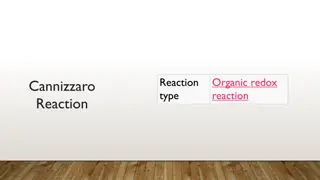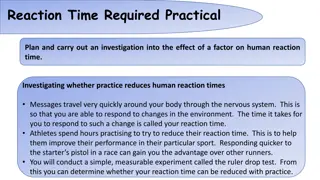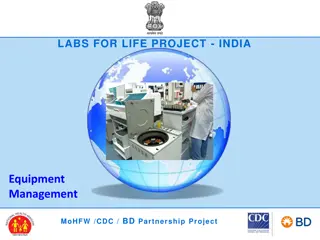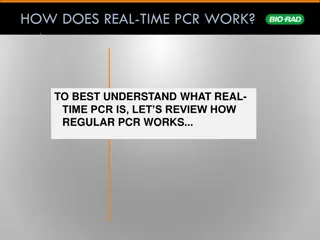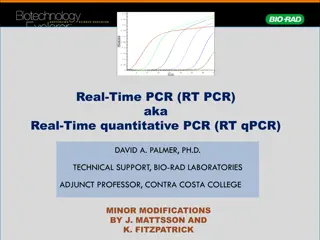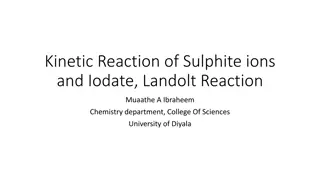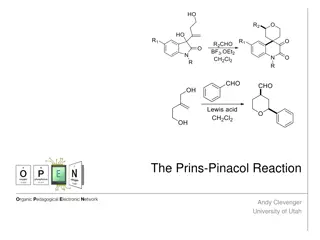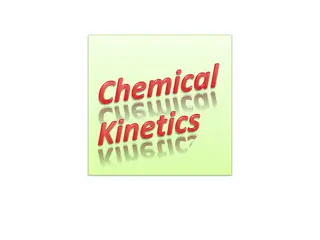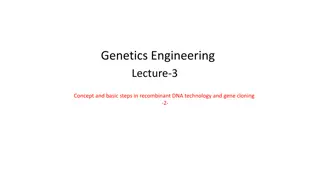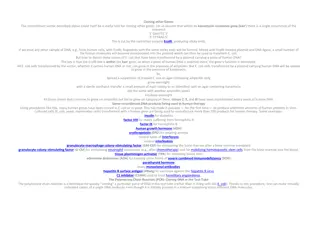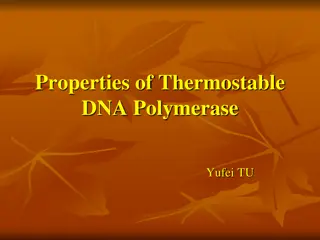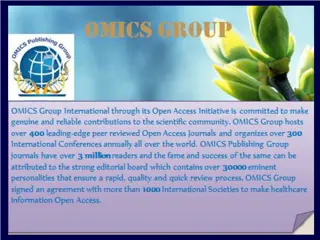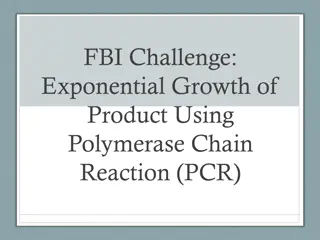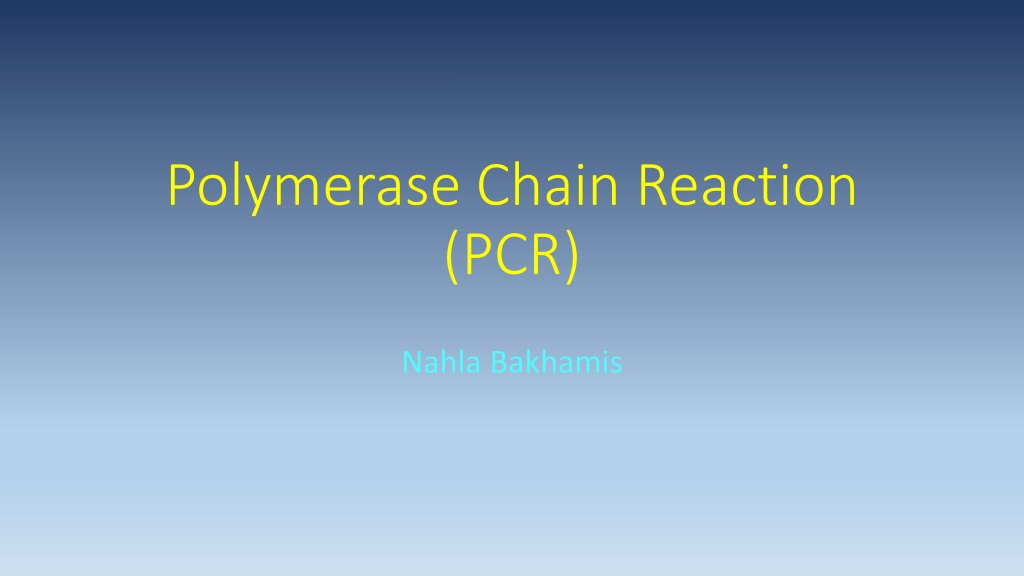
PCR: Applications, Requirements, and Properties
Explore the world of Polymerase Chain Reaction (PCR), a powerful technique for amplifying specific DNA sequences. Learn about its applications in bioinformatics, forensics, medicine, and genetic research, as well as the key requirements and properties essential for successful PCR reactions.
Download Presentation

Please find below an Image/Link to download the presentation.
The content on the website is provided AS IS for your information and personal use only. It may not be sold, licensed, or shared on other websites without obtaining consent from the author. If you encounter any issues during the download, it is possible that the publisher has removed the file from their server.
You are allowed to download the files provided on this website for personal or commercial use, subject to the condition that they are used lawfully. All files are the property of their respective owners.
The content on the website is provided AS IS for your information and personal use only. It may not be sold, licensed, or shared on other websites without obtaining consent from the author.
E N D
Presentation Transcript
Polymerase Chain Reaction (PCR) Nahla Bakhamis
Multiple copies of specific DNA sequences; Molecular Photocopying
Polymerase Chain Reaction 1983; In vitro enzymatic amplification of specific DNA sequences from the genome (2 regions of known sequence). As many as billion times C T T A C C G T G G T A A A T C G G A A T G G C A C C A T T T A G C
PCR Properties: Rapid & easy. Sensitive. Robust. Widespread applications; Bioinformatics, forensics, medicine and genetic research.
PCR uses: Replacement of cloning. Diagnosis of chromosomes abnormalities (QF-PCR). Diagnosis of single gene defect. Searching for genes and mutations. Cancer genetics.
PCR requirements: Known DNA seq of target region. Primers 18-25 bases. Thermo-stable DNA polymerase Taq-polymerase dNTPs Thermal cycler.
Reagents for PCR reaction: DNA template (1-5 L). 2 primers (1-3 L); if excess Primer-dimer - complementary to 3 end - length 18-25 bp - CG content 45-60% Master mix: a. Taq-polymerase b. dNTPs deoxynucleoside triphosphates. c. Buffer d. Cofactors; Mg2+, Mn2+ and potassium ions
Properties of the polymerase: Isolated from Thermus aquaticus. Heat stable (half-life 30min at 95c). No proof reading function in 3 to 5 direction. Primer extension up to 100bases/sec.
Primer-dimer: each other at 3 end due to complementary bases in the primers. Extended primers are no longer available to prime target for PCR. Polymerase amplify the dimer Results from primers annealing atcggactatcga gctatacttatggcca atcggactatcgatatgaataccgga tagcctgatagctatacttatggcca
Stages in PCR: 1. Denaturation: Heat to separate ds (93-95c) 2. Annealing: Primers bend to complementary seq (50-70c). 3. Elongation: adding of dNTPs.
Analysis of PCR products: Gel electrophoresis Southern hyperdization Restriction digestion Denaturing gradient gel electrophoresis DGGE: detect 95% of mutations Florescent PCR
Analysis of PCR products: Florescent PCR: Primers labelled with florescent molecule at 5 end Products detected by laser analysis system: - exact sizing of PCR products - can use more than one colour of florescent ABI 310 Prism
Problems affecting PCR: Problem Possible reasons No product Primer annealing? Product of incorrect size Primer annealing else where in the genome? Several products formed Contamination? Several annealing sites?
PCR rxn inhibitors: Proteinase K ---- digest polymerase Phenol --------- denature the polymerase
Advantages of PCR: Uses less patient DNA Quick results (3hrs) Usually no radioactive materials Precise in determining sizes of alleles Detect point mutation Less expensive
Limitations of PCR: Target DNA sequence must be known Errors of Taq-polymerase Size limitation (CG triplet repeats)
PCR based technologies: 1. Multiplex PCR: 1988 Single template or multiple template Different Pb length, to form distinct bands. Target seq different enough. Save time, effort Cross hyperdization or miss-priming
2. QF-PCR; Quantitative florescent PCR Primers tagged with florescent label; Different colour & size (polymorphic markers). Used to know: -If the seq is present or not -No of copies in the sample Analysed by; automated genetic analyser.
QF PCR for prenatal diagnosis: Detect aneuploidy 13, 18, 21 & recently X chr. CVS or amnio results in less than 2 days Looking for ratio 1:1 or 2:0 (normal) Or 1:1:1, 2:1 or 3:0 (trisomy).
3.q-PCR; real time PCR: 1996 amplified DNA is detected as the reaction progresses real-time Uses: genotyping, mutation detection, gene expression Instrumentation: -ABI TaqMan: 96-well Block cycler with fluorimeter. -Roche Lightcycler: Glass capillary reaction tubes, 40 cycles in 15-20 min.
3.q-PCR; real time PCR: **Compare sample by normalising control
4- RT-PCR: Reverse transcriptase PCR: Use mRNA as a template to produce cDNA; Reverse transcriptase enzyme cDNA is then amplified to screen possible mutations directly. Reverse transcriptase enzyme
Uses of RT-PCR: Diagnosis of genetic diseases (RNA). Gene expression Insertion of eukaryotic genes into prokaryotes Studying the genomes of viruses composed of RNA; Influenza virus A HIV
Thank you Questions?


